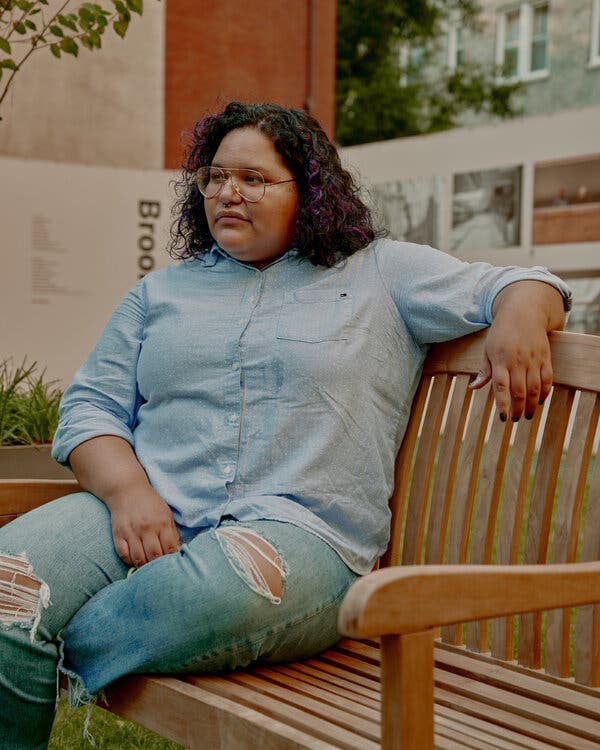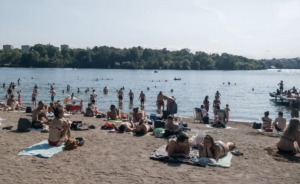What will it take for New Yorkers to process the events of the past few months — the emotional toll of thousands of deaths, social unrest, economic insecurity and the abrupt cessation of life as we knew it? The New-York Historical Society is hoping a new exhibition, humble but moving, can offer a space for some of our feelings to catch up with us.
“Hope Wanted: New York City Under Quarantine” is an exhibition of oral histories and photography of New Yorkers from across the five boroughs that opens in the museum’s West 76th Street courtyard on Aug. 14. It will be one of the first new exhibitions in the city to open since the lockdown began in March, albeit in a garden, with images printed on weatherproof panels and audio content accessible via cellphones. (Across Central Park, the Museum of the City of New York has an outdoor installation of crowdsourced photographs from coronavirus times on its facade and terrace.)
Among the stories featured is that of Leticia Lucero, a 29-year-old community organizer who works at the Stapleton NYCHA housing in Staten Island. Visitors can use their cellphones to listen to the audio she recorded during the peak of the pandemic — when the virus was killing hundreds of New Yorkers every day — describing the grueling, weekslong wait for her and her brother’s coronavirus test results to come back.
Ms. Lucero, who wears gold aviator glasses and has purple streaks in her hair, lives with her mother and siblings, all of whom are employed in essential service jobs. Her mother is a home health aide. Her sister works at a school. Her brother works in a pediatric clinic, where several colleagues tested positive for the virus. While none of her family members contracted the virus, the anxiety that one of them would bring it home, or infect their clients, consumed them for months.
Since the arrival of the coronavirus in the city, Ms. Lucero’s work quickly evolved into crisis management. During its peak, she was part of a team giving out care packages containing food, hand sanitizer, masks and gloves to NYCHA residents. As the virus has waned in the city, and a housing crisis looms, she has pivoted to assembling and organizing resources and outdoor events to educate people about their options if they cannot pay rent — like applying for a “one-shot deal” grant through the city.
Caught over the phone in early August, Ms. Lucero paused to consider her recent experiences. “There’s no time to think or digest,” she observed. “We’re at a go-go-go pace, but then there are moments when I actually have a bit of time, and I can take a breath. And when you take that breath, it feels a little painful.” Providing vital resources to those most in need has kept her sane, she explained. “I think that if I wasn’t doing the job that I do now, I would be falling apart.”
The stories and photographs that compose “Hope Wanted” were captured by the writer Kevin Powell and the photographer Kay Hickman, in early April. They hired a driver, Hany Nashed, and spent two surreal days traveling across the city — from the Bronx to Staten Island, Queens, Brooklyn and Manhattan — interviewing friends and acquaintances of Mr. Powell and photographing them through windows, on stoops, and out of car windows, including an anonymous gravedigger on Hart Island, where unclaimed victims of Covid-19 have been buried.
“In a lot of ways I needed to do this so I didn’t lose my mind,” Mr. Powell reflected by phone from his home in Fort Greene, Brooklyn. “I felt very powerless, very helpless. I was having a lot of severe nightmares just because of everything that was happening. It was a lot of emotional turmoil. I knew people who were sick. I lost a family member. I can’t just sit here and not help in some way to tell the story of what’s happening.”
Mark Naison, a 74-year-old Fordham University professor whose words and portrait are featured in the exhibition, understands how gathering tales of the pandemic can help to lift weary spirits. When the coronavirus surged through New York in April, he felt depressed and angry. The Fordham campus closed suddenly, and classes moved online. In addition to the fear that had settled over him, he had lost the two things that “lit up his life,” he said recently over the phone — regular in-person contact with his students, and playing tennis.
He tried to cheer up his students by recording himself doing raps, and invited them to open up about their feelings and experiences in papers and in Friday afternoon Zoom happy hours. Over the next couple of months, two of his students would lose parents, while others would be thrown into profound economic hardship.
But then something changed. His students began participating in Black Lives Matter protests around the country, and a few of them started collecting oral histories from people around the Bronx. Dr. Naison, fueled by a new sense of purpose and hope, began fund-raising to pay them to do that work. “By the end of the semester, I felt this surge of energy and creativity coming from the students,” he recalled.
“They’ve been so inspired by the resilience and courage of the people they interviewed,” he continued, like Maribel Gonzalez, the owner of a Bronx culinary institution, The South of France, a Puerto Rican restaurant, who has been delivering free food to homebound seniors even as the survival of her business hangs in the balance. “They say they cry every time they watch the interview,” Dr. Naison said.
If stories beget stories, the New-York Historical Society is betting that “Hope Wanted” will generate more. An open-air story booth positioned at the center of the exhibition invites visitors to take a moment to call in their lockdown experiences to a voice mail message box. Some of these accounts will end up in the institution’s collection, alongside the materials gathered by Mr. Powell and Ms. Hickman.
The Coronavirus Outbreak ›
Frequently Asked Questions
Updated August 12, 2020
-
Can I travel within the United States?
- Many states have travel restrictions, and lots of them are taking active measures to enforce those restrictions, like issuing fines or asking visitors to quarantine for 14 days. Here’s an ever-updating list of statewide restrictions. In general, travel does increase your chance of getting and spreading the virus, as you are bound to encounter more people than if you remained at your house in your own “pod.” “Staying home is the best way to protect yourself and others from Covid-19,” the C.D.C. says. If you do travel, though, take precautions. If you can, drive. If you have to fly, be careful about picking your airline. But know that airlines are taking real steps to keep planes clean and limit your risk.
-
I have antibodies. Am I now immune?
- As of right now, that seems likely, for at least several months. There have been frightening accounts of people suffering what seems to be a second bout of Covid-19. But experts say these patients may have a drawn-out course of infection, with the virus taking a slow toll weeks to months after initial exposure. People infected with the coronavirus typically produce immune molecules called antibodies, which are protective proteins made in response to an infection. These antibodies may last in the body only two to three months, which may seem worrisome, but that’s perfectly normal after an acute infection subsides, said Dr. Michael Mina, an immunologist at Harvard University. It may be possible to get the coronavirus again, but it’s highly unlikely that it would be possible in a short window of time from initial infection or make people sicker the second time.
-
I’m a small-business owner. Can I get relief?
- The stimulus bills enacted in March offer help for the millions of American small businesses. Those eligible for aid are businesses and nonprofit organizations with fewer than 500 workers, including sole proprietorships, independent contractors and freelancers. Some larger companies in some industries are also eligible. The help being offered, which is being managed by the Small Business Administration, includes the Paycheck Protection Program and the Economic Injury Disaster Loan program. But lots of folks have not yet seen payouts. Even those who have received help are confused: The rules are draconian, and some are stuck sitting on money they don’t know how to use. Many small-business owners are getting less than they expected or not hearing anything at all.
-
What are my rights if I am worried about going back to work?
- Employers have to provide a safe workplace with policies that protect everyone equally. And if one of your co-workers tests positive for the coronavirus, the C.D.C. has said that employers should tell their employees — without giving you the sick employee’s name — that they may have been exposed to the virus.
-
What is school going to look like in September?
- It is unlikely that many schools will return to a normal schedule this fall, requiring the grind of online learning, makeshift child care and stunted workdays to continue. California’s two largest public school districts — Los Angeles and San Diego — said on July 13, that instruction will be remote-only in the fall, citing concerns that surging coronavirus infections in their areas pose too dire a risk for students and teachers. Together, the two districts enroll some 825,000 students. They are the largest in the country so far to abandon plans for even a partial physical return to classrooms when they reopen in August. For other districts, the solution won’t be an all-or-nothing approach. Many systems, including the nation’s largest, New York City, are devising hybrid plans that involve spending some days in classrooms and other days online. There’s no national policy on this yet, so check with your municipal school system regularly to see what is happening in your community.
“There’s something very personal and even intimate about getting those first-person stories that you can’t necessarily replicate through objects and ephemera,” said Margaret K. Hofer, vice president and director of the museum division of New-York Historical Society, who is overseeing the collection. “The objects tend to be symbolic stand-ins for experience, while the oral histories are quite immediate.”
For Mr. Powell, the originator of “Hope Wanted,” the story that has stuck with him is that of Tanya Fields, or “Mama Tanya” as she is known, whose image opens the exhibition. A Bronx mother of six who came down with the virus in March, along with all of her children except for the youngest, Ms. Fields survived the pandemic’s first wave in New York City.
But today, she is still weathering the consequences: She has trouble breathing and is plagued by worries for her children as their schooling is thrown into disarray. Local playgrounds are hotbeds of fear, with little social distancing and mask-wearing. She lives with daily frustration and anger about the inept government response to the pandemic. The public officials “are more concerned with lining their own pockets and rhetoric than listening to people who actually know better, the epidemiologists, the scientists, the social justice activists,” she said over the phone recently.
Yet the organization she founded, the Black Feminist Project, has seen a groundswell of local support during the pandemic. Through its urban farm, Black Joy Farm, Ms. Fields and her recently expanded team of five have been giving away hundreds of pounds of food every week via their Corona-Relief Food Box.
It may be an acute failure of government that has led Ms. Fields’s organization to fill the needs of close to 200 families every week, but her story is inspiring nonetheless.
For Mr. Powell, that’s what the oral histories all come down to. “It’s healing,” he said, looking around at the exhibition installation on Monday evening. “We have to get people hope. That’s what we desperately need, especially because we don’t know how long this will go on for.”
Hope Wanted: New York City Under Quarantine
Through Nov. 29 at the New-York Historical Society, 170 Central Park West, Manhattan; 212-873-3400, nyhistory.org.



















